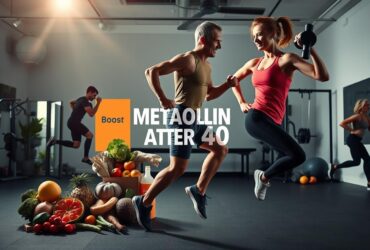In the intricate landscape of hormone health, testosterone frequently takes center stage, revered for its pivotal role in energy, mood, and overall well-being. As men and women alike navigate the challenges of hormonal imbalances, the debate surrounding testosterone replacement therapy (TRT) intensifies, particularly when contrasting various administration methods. Among these, the choice between topical applications and injectable forms stands out as a crucial consideration. This article delves into the nuances of testosterone replacement therapy versus injections, examining the benefits, drawbacks, and personal preferences that shape this vital decision. With a wealth of information at your fingertips, we aim to illuminate the path to understanding how best to embrace hormone health in a way that aligns with individual lifestyles and needs.
Understanding Testosterone Replacement Therapy: An Overview of Options
Testosterone replacement therapy (TRT) offers a variety of methods for men seeking to balance their hormone levels, and two of the most popular options are injections and transdermal delivery systems. Injections typically involve either intramuscular or subcutaneous administration, allowing for direct absorption into the bloodstream. This can result in rapid increases in testosterone levels, providing quick relief from symptoms such as fatigue, low libido, and mood swings. On the other hand, transdermal systems include patches or gels, which deliver testosterone slowly over time, maintaining more stable hormonal levels with less fluctuation between doses.
When considering these therapies, it’s essential to weigh factors such as convenience, side effects, and personal preference. Here’s a quick comparison of these two options:
| Feature | Injections | Transdermal Systems |
|---|---|---|
| Administration Frequency | Weekly to biweekly | Daily |
| Effect Duration | Short-term peaks | Steady release |
| Pain Level | Moderate (injection site) | Minimal (topical) |
| Blood Level Stability | Variable | More stable |
The choice between testosterone injections and transdermal therapy largely depends on individual lifestyles and specific medical considerations. Consultation with a healthcare provider is crucial for finding the optimal therapy method, ensuring safe management of testosterone levels, and maximizing overall health benefits. Understanding these differences allows patients to make informed choices that align with their treatment goals.

Exploring the Mechanics of Injections: Benefits and Drawbacks
When considering testosterone replacement therapy through injections, the mechanics behind the process reveal several specific advantages. One significant benefit is the rapid absorption of the hormone into the bloodstream, allowing for quick elevation of testosterone levels. This method is particularly advantageous for individuals facing severe deficiencies. Additionally, injections can be tailored to the patient’s needs, with various formulations available—ranging from short-acting to long-acting options. These characteristics can lead to more personalized treatment plans that suit different lifestyles and response rates.
However, there are also notable drawbacks associated with injections that potential patients should consider. Among these, the pain and discomfort from needle injections can deter individuals from pursuing this option long-term. There’s also the possibility of adverse reactions, including bruising, swelling, and in some cases, infection at the injection site. Moreover, patients may face scheduling challenges due to the required regular visits to a healthcare provider for their injections, often leading to concerns over compliance and adherence to the treatment protocol. These factors create a balanced landscape of pros and cons that each individual must assess based on their personal health goals and lifestyle.

Sublingual and Transdermal Alternatives: A Comparative Analysis
The advent of sublingual and transdermal therapies has transformed the landscape of testosterone replacement. Distinct from traditional injections, these alternatives offer unique routes of administration that may appeal to those seeking a more manageable experience. Sublingual tablets, designed to dissolve under the tongue, enable rapid absorption into the bloodstream, resulting in a swift onset of effects. Meanwhile, transdermal patches deliver a steady release of testosterone through the skin, ensuring consistent hormone levels without the peaks and troughs associated with injectable forms. Each method, therefore, presents its own benefits and challenges:
- Sublingual: Quick absorption and ease of use.
- Transdermal: Continuous release and less frequent dosing.
- Injections: Higher testosterone levels can be achieved quickly.
Considering side effects, both alternatives tend to present fewer issues compared to injections, which can lead to discomfort at the injection site or fluctuations in hormone levels. Users may also appreciate the reduced requirement for frequent medical visits associated with injections. A comparative analysis might illustrate the distinctions in efficacy, ease of use, and patient satisfaction. Below is a concise overview highlighting these factors:
| Method | Efficacy | Onset | Frequency |
|---|---|---|---|
| Sublingual | High | Fast | Daily |
| Transdermal | Moderate | Gradual | Weekly |
| Injections | Very High | Immediate | Bi-weekly |

Cost Considerations: Financial Implications of Different Therapies
The financial landscape of testosterone replacement therapy (TRT) is multifaceted, often influenced by the type of therapy selected. When comparing TRT through patches or gels to that of injections, several cost factors come into play:
- Initial Cost: Injections may require a higher upfront investment for medical appointments and the medications themselves, especially if administered at a clinic.
- Insurance Coverage: Coverage can vary significantly, with some plans covering more for injections than for topical treatments, or vice versa.
- Long-Term Expenses: Consistently using injections typically leads to lower monthly costs compared to the recurring expense of purchasing patches or gels, which may have a higher per-dose price.
Additionally, potential side effects and complications should be taken into account, as they could lead to unforeseen medical expenses. To illustrate the distinctions,here’s a comparative overview:
| Type of Therapy | Initial Cost | Monthly Cost | Insurance Coverage |
|---|---|---|---|
| Patches/Gels | Moderate | Higher | Varies widely |
| Injections | Higher | Lower | Generally better coverage |
Monitoring and Side Effects: What to Expect During Treatment
As you embark on testosterone replacement therapy (TRT), it’s essential to keep a close eye on your body’s response to the treatment. Regular monitoring is crucial to ensure that the therapy is effective and to mitigate any potential adverse effects. This typically involves routine blood tests to assess testosterone levels, hematocrit (red blood cell count), and other relevant hormones. Depending on the type of administration—whether injections or other methods—patients can expect to track these key indicators:
- Testosterone Levels: Assessing whether they’re within the optimal range.
- Hematocrit Levels: Monitoring for potential increases that could lead to clotting issues.
- Estrogen Levels: Checking for any hormonal imbalances.
Side effects can vary based on individual responses and the mode of delivery. Commonly reported issues associated with TRT may include mood swings, changes in libido, or injection-site reactions in patients receiving injections. It’s important to remain vigilant about these signs and communicate them to your healthcare provider. Below is a simple overview of possible side effects to watch for:
| Side Effect | Frequency |
|---|---|
| Mood Changes | Moderate |
| Injection Site Pain | Common |
| Increased Red Blood Cell Count | Occasional |
| Acne or Oily Skin | Common |
Personalizing Your Treatment Plan: Factors to Consider for Optimal Results
When it comes to testosterone replacement therapy (TRT), personalizing your treatment plan is crucial for achieving optimal results. One of the primary factors to consider is the method of delivery. Injections, for instance, can offer a rapid boost in testosterone levels, but they often require frequent administration, which can be inconvenient. Alternatively, testosterone gels or patches provide a more steady release throughout the day, making them a preferred choice for some individuals. However, skin sensitivity or lifestyle factors, such as daily routines and occupational environments, can influence the effectiveness of these methods.
Another important aspect to consider is the individual’s unique physiological profile. Factors such as age, current hormone levels, health conditions, and lifestyle choices must all be evaluated when determining the most suitable TRT method. A personalized approach not only enhances the efficacy of the therapy but also minimizes potential side effects and risks. Below is a summary of various factors that may influence treatment personalization:
| Factor | Considerations |
|---|---|
| Age | Older patients may require different dosages. |
| Hormone Levels | Initial testosterone levels inform treatment strength. |
| Health Conditions | Chronic conditions may affect therapy choices. |
| Lifestyle | Activity level can influence absorption and effectiveness. |
Expert Recommendations: Making an Informed Choice for Your Health
When considering testosterone replacement therapy, it’s essential to weigh the benefits and drawbacks of different delivery methods. Injections tend to provide a rapid increase in testosterone levels and are generally cost-effective. Patients often appreciate the convenience of fewer appointments, as some may only require a shot every few weeks. However, they can involve discomfort at the injection site and may cause fluctuations in hormone levels, leading to potential mood swings or energy dips throughout the cycle.
On the other hand, topical formulations, such as gels or patches, offer a more stable hormone level but may take longer to show results. These options are generally user-friendly and can be incorporated seamlessly into daily routines. Nonetheless, they run the risk of unintentional transfer to others and might require more frequent application. Before making a decision, it’s advisable to consult with healthcare professionals to discuss personalized experiences and potential side effects. Below is a comparison table to visualize key characteristics of each method:
| Method | Pros | Cons |
|---|---|---|
| Injections |
|
|
| Topical |
|
|
Q&A
Q&A: Testosterone Replacement Therapy vs. Injections
Q1: What is testosterone replacement therapy (TRT)?
A1: Testosterone replacement therapy (TRT) is a medical treatment designed to restore testosterone levels in individuals who have low testosterone, also known as hypogonadism. This therapy can encompass various delivery methods, including injections, gels, patches, and pellets, each with its own unique features and benefits.
Q2: How do testosterone injections work?
A2: Testosterone injections directly deliver the hormone into the bloodstream, typically administered intramuscularly or subcutaneously. This allows for a more immediate rise in testosterone levels, which can be beneficial for patients looking for rapid results. Injections can be either short-acting, requiring more frequent dosing, or long-acting, which may last several weeks before a booster is needed.
Q3: What are the advantages of testosterone injections?
A3: One of the major advantages of testosterone injections is their effectiveness in rapidly elevating testosterone levels. Many patients report noticeable improvements in energy, mood, and libido shortly after their injections. Additionally, injections are typically more cost-effective compared to other forms of TRT and are often covered by insurance.
Q4: Are there any downsides to using testosterone injections?
A4: While injections can provide quick results, they may also come with some drawbacks. Patients may experience discomfort at the injection site and the need for regular appointments or self-injection. There is also the potential for fluctuations in testosterone levels, leading to “highs and lows” in mood and energy between doses.
Q5: What are other forms of TRT, and how do they compare to injections?
A5: Other forms of TRT include topical gels, patches, and pellet implants. Gels and patches offer a more consistent absorption of testosterone and can be applied daily. They eliminate the need for needles but may require extra caution to prevent transferring testosterone to others. Pellets provide a long-lasting solution, releasing testosterone gradually over several months, but require a minor surgical procedure for insertion.
Q6: Who is a candidate for testosterone replacement therapy?
A6: Ideal candidates for TRT are typically adult men experiencing symptoms of low testosterone, such as fatigue, reduced sex drive, mood changes, and loss of muscle mass, along with confirmed low testosterone levels through blood tests. However, the decision to initiate therapy should be made in conjunction with a healthcare provider, who can assess individual health status and needs.
Q7: Can lifestyle changes impact the need for testosterone therapy?
A7: Absolutely! Lifestyle factors such as diet, exercise, weight management, and stress levels can significantly affect testosterone levels. Many individuals may see improvement in their symptoms by making lifestyle changes before considering TRT. Regular physical activity, a balanced diet rich in nutrients, and stress management practices can all play a role in optimizing hormonal health.
Q8: Is testosterone replacement therapy safe?
A8: TRT can be safe for many, but it isn’t without risks. Potential side effects may include increased red blood cell count, sleep apnea, acne, and an increased risk of cardiovascular issues. Regular monitoring by a healthcare professional is essential to ensure the therapy remains beneficial without introducing harmful side effects.
Q9: What do I need to consider when choosing between testosterone injections and other forms of TRT?
A9: When deciding between testosterone injections and other forms of therapy, consider factors such as your lifestyle, comfort with self-injections, frequency of administration, and personal preference for handling medications. Consulting with a healthcare professional can also provide insights tailored to your health needs and concerns.
Q10: How can someone get started with testosterone replacement therapy?
A10: To begin TRT, the first step is to consult a healthcare provider experienced in hormone replacement. They will conduct a thorough evaluation that includes a physical exam, blood tests to measure testosterone levels, and discussions about your symptoms and medical history. Based on this assessment, they will recommend the most suitable course of action, whether that be injections or another form of therapy.
In Conclusion
the quest for optimal health and well-being is a deeply personal journey, and the choice between testosterone replacement therapy and injections is no exception. As we’ve explored, each option comes with its own set of advantages and considerations, tailored to varied lifestyles and medical needs. Whether you lean towards the convenience of gels and patches or the targeted precision of injections, it’s essential to engage in an informed dialogue with your healthcare provider. Ultimately, the best path forward is one that harmonizes with your individual health goals and circumstances. In the ever-evolving world of hormone therapy, knowledge is not merely power—it’s the cornerstone of empowerment in reclaiming your vitality. So, as you navigate this nuanced terrain, may your decision lead you closer to the balance and energy you seek.










